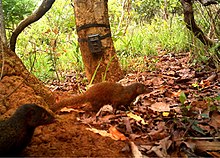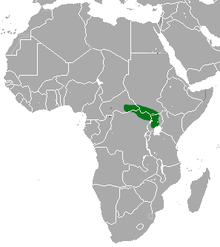Pousargues's mongoose
| Pousargues' mongoose | |
|---|---|

| |
| Wild Pousargues' Mongoose in the Chinko Project Area. | |
| Scientific classification | |
| Kingdom: | |
| Phylum: | |
| Class: | |
| Order: | |
| Family: | |
| Subfamily: | |
| Genus: | Dologale Thomas, 1920
|
| Species: | D. dybowskii
|
| Binomial name | |
| Dologale dybowskii Pousargues, 1893
| |

| |
| Pousargues's mongoose range | |
The Pousargues's mongoose (Dologale dybowskii), also known as the African tropical savannah mongoose, is the only species in the genus Dologale.
Little is known about this species. Its range is confined to an area within the south-eastern part of the Central African Republic, and as of 2015 there had been only 31 museum specimens and a handful of sightings in the wild.[2]
Description and behaviour

Pousargues's Mongoose has a body length between 25 and 33 cm (10 and 13 in), a tail length between 16 and 23 cm (6.5 and 9 in), and weighs between 300 and 400 g (11 and 14 oz). They are brown in colour with their underside and face being grey. They have a bushy tail and strong claws on their front feet.[3]
Field work carried out between 2011 and 2015 in the south eastern part of Central African Republic revealed a population of Pousargue's Mongoose animals in the Chinko Project Area. The studied Pousargues’s mongoose population shares its jungle home with eight different species of mongoose, and Pousargues’s Mongoose seem to occur in much lower densities than most other mongoose in the Chinko Project Area.
Observations from the Chinko show that Pousargues’s mongoose lives in small groups ranging from three to 12 individuals which move between their favourite termite mounds on a regular basis. Breeding has been observed taking place in mid-May during the early rainy season. A small group of three adults have been observed caring for an infant, carrying it around in their mouths.
Taxonomy
A genetic study focused on Carnivora highlighted the Pousargues’s mongoose to be the sister-species of the genus Helogale.[4]
Distribution and habitat
The Pousargue's mongoose is native to open savanna areas of northern Democratic Republic of the Congo, western Uganda, South Sudan, and Central African Republic.[5][6]
Conservation status
The Pousargues's mongoose is listed as data deficient by International Union for Conservation of Nature (IUCN), with an unknown population trend.[1] There have been limited sightings of this animal in the wild, and only a few museum specimens exist. While this may indicate that the species is rare or threatened, the IUCN believes that its similar appearance and location may cause it to be mistaken for the Common Dwarf Mongoose (Helogale parvula). If so, the animal may be reclassified as Least Concern.[1]
Nomenclature
The species is named in honor of the French explorer and agronomist of Polish heritage Jean Dybowski, who collected the type-specimens between March and June 1892. The type-locality of the species corresponds to the former French garrison funded by the Dybowski Mission on the Kémo River, close to the settlement of Possel, at the border between the Central African Republic and the Democratic Republic of the Congo.[7][8]
References
- ^ a b c Aebischer, T.; Hickisch, R.; Woolgar, J.; Do Linh San, E. (2015). "Dologale dybowskii". The IUCN Red List of Threatened Species. 2015. IUCN: e.T41598A45205821. doi:10.2305/IUCN.UK.2015-4.RLTS.T41598A45205821.en. Retrieved 15 January 2018.
{{cite journal}}: Unknown parameter|last-author-amp=ignored (|name-list-style=suggested) (help) Database entry includes a brief justification of why this species is of data deficient - ^ Thierry Aebischer & Raffael Hickisch (July 20, 2015). "Pousargues's mongoose rediscovered after 20 years". Africa Geographic. Retrieved November 21, 2016.
- ^ "Pousargues's Mongoose". The Animal Files. Retrieved November 21, 2016.
- ^ Nyakatura, Katrin; Bininda-Emonds, Olaf RP (2012-02-27). "Updating the evolutionary history of Carnivora (Mammalia): a new species-level supertree complete with divergence time estimates". BMC Biology. 10: 12. doi:10.1186/1741-7007-10-12. ISSN 1741-7007.
{{cite journal}}: CS1 maint: unflagged free DOI (link) - ^ R. F. Ewer (1 January 1998). The Carnivores. Cornell University Press. p. 403. ISBN 0-8014-8493-6.
- ^ Don E. Wilson; DeeAnn M. Reeder (16 November 2005). Mammal Species of the World: A Taxonomic and Geographic Reference. JHU Press. p. 564. ISBN 978-0-8018-8221-0.
- ^ de Pousargues, Eugène (1896). Etude sur les mammifères du Congo français. 3 (in French). Vol. 8. Annales des sciences naturelles. Zoologie et paléontologie. pp. 129–416. doi:10.5962/bhl.title.8825.
- ^ de Pousargues, Eugène (1894). "Description d'une nouvelle espèce de mammifère du genre Crossarchus et considérations sur la répartition géographique des crossarques rayés". Nouvelles archives du Muséum d'histoire naturelle. 3. 6: 121–134. ISSN 0766-7248 – via Biodiversity Heritage Library.

